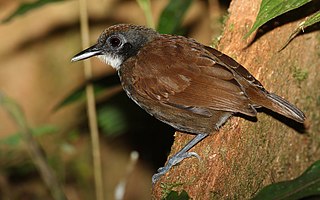
The antbirds are a large passerine bird family, Thamnophilidae, found across subtropical and tropical Central and South America, from Mexico to Argentina. There are more than 230 species, known variously as antshrikes, antwrens, antvireos, fire-eyes, bare-eyes and bushbirds. They are related to the antthrushes and antpittas, the tapaculos, the gnateaters and the ovenbirds. Despite some species' common names, this family is not closely related to the wrens, vireos or shrikes.
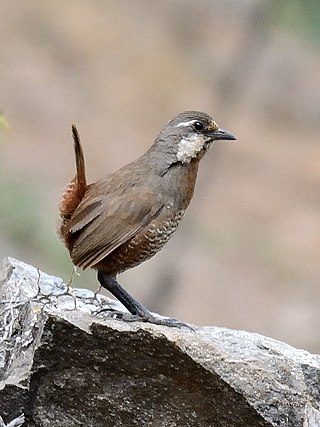
The tapaculos or tapacolos are a family, Rhinocryptidae, of small suboscine passerine birds, found mainly in South America and with the highest diversity in the Andean regions. Three species are found in southern Central America.

Formicariidae is a family of smallish suboscine passerine birds of subtropical and tropical Central and South America known as antthrushes. They are between 10 and 20 cm in length, and are most closely related to the ovenbirdss in the family Furnariidae, and the tapaculoss in the family Rhinocryptidae. The family Formicariidae contains 12 species in two genera.

Grallariidae is a family of smallish suboscine passerine birds of subtropical and tropical Central and South America known as antpittas. They are between 10 and 20 cm (4–8 in) in length, and are related to the antbirds, Thamnophilidae, and gnateaters, Conopophagidae.

The Tyranni (suboscines) are a suborder of passerine birds that includes more than 1,000 species, the large majority of which are South American. It is named after the type genus Tyrannus.
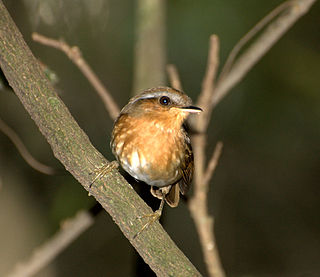
The rufous gnateater is a passerine bird of the gnateater family, Conopophagidae. It is found in forest understory and bushes in eastern Brazil from Rio Grande do Sul north to central Brazil. Its range also extends into eastern Paraguay and north-eastern Argentina and it has recently been recorded in Uruguay. It is often elusive and hard to see, but is commoner and less shy than other gnateaters.
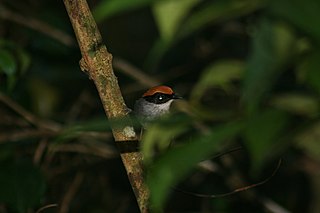
Conopophaga is a genus of birds in the gnateater family. Its members are found in forest and woodland in South America.

Pittasoma is a genus of birds in the gnateater family. Its two members breed in subtropical or tropical moist forest in South and Central America, specifically the Chocó, and Panama and Costa Rica. Formerly placed in the family Formicariidae, they were reclassified to Conopophagidae following analysis of mtDNA cytochrome b and NADH dehydrogenase subunit 2 sequences. The association between the genus Pittasoma and the 'traditional' gnateaters is also supported by traits in their natural history, morphology, vocalizations.

The jocotoco antpitta is an endangered antpitta, a bird from Ecuador and Peru. It was discovered in 1997, and scientifically described in 1999.

Scytalopus is a genus of small suboscine passerine birds belonging to the tapaculo family Rhinocryptidae. They are found in South and Central America from Tierra del Fuego to Costa Rica, but are absent from the Amazon Basin. They inhabit dense vegetation at or near ground-level and are mainly found in mountainous regions, particularly the Andes. They can be very difficult to see as they run through the undergrowth in a mouse-like fashion.

The chestnut-belted gnateater is a species of bird in the family Conopophagidae, the gnateaters. It is found in the Amazon Basin of northern Brazil, southern Colombia and eastern Peru and Ecuador; also the Guianan countries of Guyana, Suriname and eastern French Guiana. Its natural habitat is tropical moist lowland forest.

The black-cheeked gnateater is a species of bird in the family Conopophagidae endemic to Brazil. The male is distinguished by its orange crown, black face and white throat, while the female has brown plumage.

The giant antpitta is a perching bird species in the antpitta family (Grallariidae).

The black-crowned antpitta is a species of bird in the gnateater family, Conopophagidae. It is found in Colombia, Costa Rica, and Panama. Its natural habitat is subtropical or tropical moist foothill forests.

The rufous-crowned antpitta or rufous-crowned pittasoma is a species of bird in the gnateater family, Conopophagidae. It is found in Colombia and Ecuador.

Myrmelastes is a genus of passerine birds in the family Thamnophilidae. Most of these species were previously placed in the genus Schistocichla. The genus formerly included only three species, but several taxa previously considered subspecies of the spot-winged antbird have been elevated to species status.

Formicarius is a genus of passerine birds in the family Formicariidae. These birds are all found in the tropical New World, from southern Mexico south to Central America and northern South America. All are named as antthrushes, and are insectivorous forest birds. They are largely terrestrial, feeding mainly on the ground on ants and other insects.

The Ceará gnateater or Caatinga gnateater is a passerine bird of the gnateater family, Conopophagidae. It is found in forest understory and bushes in northeastern Brazil.

Tyrannides is a clade of passerine birds that are endemic of America. This group is divided into two clades that contain eleven families. The families listed here are those recognised by the International Ornithologists' Union (IOC).
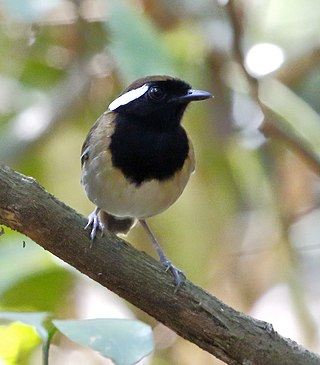
The black-breasted gnateater is a species of bird in the family Conopophagidae. It is found in Amazonian Brazil.






















